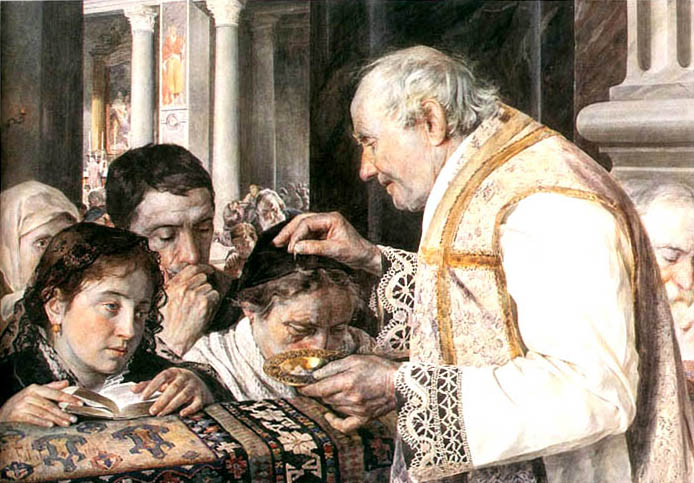What is Ash Wednesday?

This is a painting done in 1881 where a Roman Catholic priest is depicted to sprinkle ashes on the crowns of the devotees during the start of the Lenten season | WIKI COMMONS FILE
CEBU CITY, Philippines – When someone voluntarily decides to abstain or reduce his or her food intake, it is called fasting.
Fasting, in physiological and health views, is one of the many ways to lose weight. In religion, on the other hand, it is usually a ritual.
Devotees from different religions around the world, particularly Christians and Roman Catholics, practice fasting as their ways to repent sins.
This Wednesday, February 26, 2020, hundreds of Roman Catholics are expected to flock to churches to observe Ash Wednesday.
Encyclopedia Britannica defines Ash Wednesday as the first day of Lent, which occurs six and a half weeks before Easter in the liturgical year, or also known as the church year or Christian year.
The start of the lent for Roman Catholics is observed through fasting, praying, and having their forehead marked with the shape of the cross.
For Catholics, fasting comes in many ways–through avoiding pork and eating only one full meal, abstaining alcoholic beverages, and not engaging in a frivolous lifestyle.
ORIGINS
Penance, or a devotee’s practice of repenting his or her sins, can be traced back to Ancient Rome, where sinners and penitents are placed apart from the rest of the public.
Before reintegrating into the Christian community, they are subjected to a “period of public penance” from the start of Lent until Maundy Thursday.
During this span of time, penitents and “grievous sinners are sprinkled with ashes and dressed in sackcloth.”
“When these practices fell into disuse, the beginning of the penitential season of Lent was symbolized by placing ashes on the heads of the entire congregation,” Encyclopedia Britannica stated.
In modern times, palms used in the previous liturgical year are burned. The ashes, in turn, will be used during the observance of Ash Wednesday.
The marking of ash has then become a symbol or sign of penance.
COVID-19
The Catholic community in the Philippines, however, went abuzz when the Catholic Bishops Conference of the Philippines (CBCP) recommended churches nationwide to sprinkle, instead of marking the forehead, with ashes this Wednesday.
Read: Palma recommends following CBCP’s COVID-19 guidelines
CBCP’s suggestion stemmed from the threats brought about by the Coronavirus Disease 2019 (COVID-19).
Archbishop Romulo Valles, CBCP President, was quoted on the advisory saying that the sprinkling of ashes on the crown or head of devotees is not new.
Read: Lent at the time of COVID-19
“This is not an innovation but in accord with the ancient practice of the Church,” Valles said. /bmjo
Disclaimer: The comments uploaded on this site do not necessarily represent or reflect the views of management and owner of Cebudailynews. We reserve the right to exclude comments that we deem to be inconsistent with our editorial standards.
